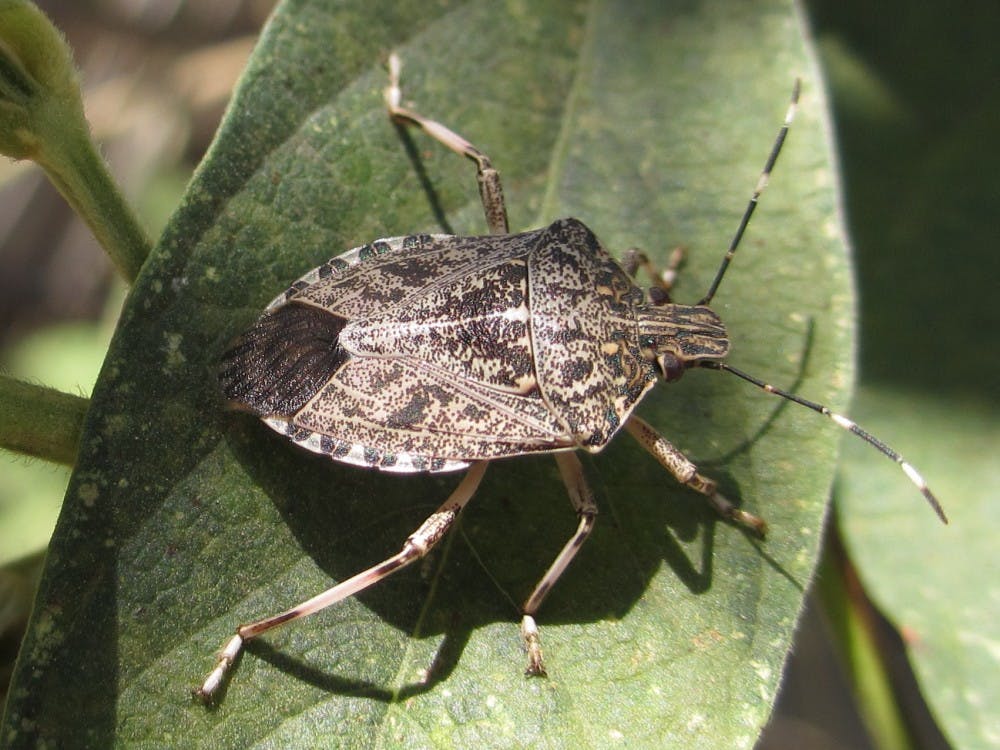Stink bugs can be a menace in gardens and inside homes, but the small insects have made their way around campus, as well.
Although they can't sting or bite you, stink bugs are known for the characteristic smell they emit through holes in their abdomens as a defense mechanism.
Local Orkin pest control consultant Jeff Brite said he's seen his fair share of stink bugs in and around Muncie, and while it's not infrequent for him to get calls about the bugs, he prefers to educate customers before attempting to exterminate.
"They can't hurt you, but they can be a real nuisance," Brite said. "There's nothing to really be afraid of, but they are something to educate yourself about if you're seeing them around a lot."
What are they?
There are 4,700 species of stink bugs in the world, with about 250 in the U.S. and Canada, according to North Dakota State University. Muncie's most common is the brown marmorated stink bug (Halyomorpha halys).
"It got its name from the brown marble pattern on its back," Brite said. "If you want to know if it's actually a stink bug, look for a five-sided, shield-shaped body and if it's about the size of your thumb nail."
How did they get here?
Purdue reported in 2010 that stink bugs had been identified in Indiana. As opposed to native strains of stink bugs found, this exotic pest is originally from Japan, China and Korea and was first reported in the United States in 1998 in Pennsylvania.
"I first started getting a lot of questions and calls about five years ago," Brite said. "They're most prominent in the fall, but once winter hits, they start making their presence known inside the home."
Stink bugs are now found in more than 40 states.
Why are they coming inside?
Stink can live for six months to a year, so some people get them in their houses during the winter, and they'll hibernate while it's warm, Brite said.
"If you have an indoor problem with stink bugs, it's most likely because of the types of trees surrounding your house or your dorm room," Brite said. "The bugs tend to like to eat the leaves and seeds from the black locust, maple, ash and catalpa trees."
While they're annoying, Brite said they cannot cause any significant structural or cosmetic damage to homes, but if not managed, they can congregate in large groups and begin flying around open areas inside.
How do I kill them?
Managing stink bugs can be challenging because there are currently few effective pesticides labeled for use against them.
For homeowners, Brite suggests a simple, nontoxic mix of soapy water (1:2 soap to water) in a household spray bottle.
"They're real touch and go this time of year," Brite said. "If they're in your house or dorm, they probably haven't eaten in several months, so they're easier to kill."
When they die, will they stink?
Leaving large numbers of stink bugs in hard to reach places may attract other pests such as carpet beetles or mice, Brite said.
When the bug finds a site that's suitable for hibernation, it releases a chemical scent that attracts other stink bugs to the area.
"This isn't the same thing that makes them stink, though," Brite said. "The stink bug's smell is a defense mechanism against birds and other insects, but just holding the bug, injuring it, or trying to move it around can cause it to release the smelly odor."
Killing a stink bug will not attract more of the bugs, however, Brite said.
How do I keep them out of my house?
Prevention in the fall is key, Brite said. For houses, sealing all cracks around windows, doors, siding, utility pipes, behind chimneys and underneath the wood and other openings with high quality silicone or silicone-latex caulk should keep the stink bugs out.
"If you begin to find them in your house, they're really hard to get rid of quickly because they'll hide in cracks and crevices for months" Brite said. "If they're constantly in your dorm room, you may want to consider remove the window air conditioners, repairing any broken screens outside of the window and using duct tape to seal the cracks and edges around the window pane."
Some students said they see stink bugs in various places around the campus, but dorm rooms are a hot spot for them.
"I've seen the bugs, usually once every few days, but I mainly see them in my dorm room," said Clinton Green, a freshman actuarial science major. "Personally, I'm not a fan of insects, but I would say I feel uncomfortable by the presence of stink bugs."
Green, a resident in Mysch/Hurst, wasn't alone in his thinking. Freshman animation major Madison Aschliman said she's seen the bugs crawling around her room in multiples.
"They're hard to get rid of, and my parents have them in their house and you can never really get all of them," Aschliman said. "They are gross, and I really don't want them crawling around."
If students are seeing larger than average numbers of stink bugs in dorm rooms or around campus, Brite suggested contacting Ball State maintenance for further guidance and assistance.





